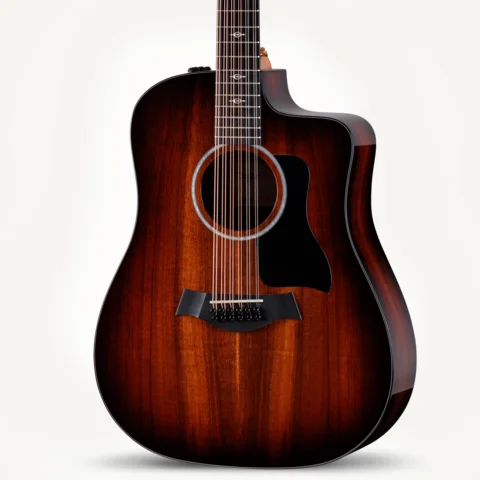Ed. Note: Taylor’s Director of Natural Resource Sustainability, Scott Paul, shares an update on two major initiatives he has been engaged in this past year: working to amend recently enacted CITES trade regulations for Dalbergia rosewood; and forging promising new partnerships that aim to scale up the propagation and replanting of ebony in Cameroon.
A Closer Look at CITES Rosewood Regulations
The Convention on International Trade in Endangered Species of Wild Fauna and Flora (CITES) is a multilateral treaty that went into force in 1975 to protect endangered plants and animals. Taylor Guitars fully supports the Convention. Yet, as many guitar owners know, in October of 2016 CITES voted to make a change in the protected status of rosewood, listing all species of Dalbergia (except for Brazilian rosewood, Dalbergia nigra, which was already listed in Appendix I), as Appendix II. (The change officially went into effect January 2, 2017.) This decision has had a profound impact on manufacturers and owners of musical instruments, new and used, that are made with any rosewood components.
It’s important to understand that the politics behind this listing were not driven by musical instruments or the species traditionally used to make them. It was driven by escalating Asian demand for hongmu furniture. The word “hongmu” means “red wood” in Chinese, and the term refers to a range of red-colored tropical hardwoods used to produce a certain style of furniture. In the past, only royalty and elites were privileged to own hongmu. However, in recent years China’s growing middle class has acquired a taste for this style of furniture, resulting in a greatly escalated demand. Hongmu furniture is also increasingly popular in Vietnam.
In short, the growing demand for hongmu furniture coupled with, at times, poor governance and rampant illegalities in many countries where hongmu species grows has resulted in a global run on many red-colored rosewoods. As a result, CITES moved Dalbergia to Appendix II and drafted a new governing Annotation. As stated on the CITES website (cites.org), Appendix I includes species threatened with extinction. Trade in specimens of these species is permitted only in exceptional circumstances. Appendix II includes species not necessarily threatened with extinction, but in which trade must be controlled in order to avoid utilization incompatible with their survival.
Despite the good intent, it quickly became apparent that the new listing was too broad in scope and the governing Annotation was ambiguously written. Additionally, it should be noted that in the lead-up to the listing, the focus was almost exclusively on the serious loss of red Dalbergia species feeding the Asian furniture market. At the time, apparently no one was even considering musical instruments or the brownish-colored rosewoods used traditionally for musical instruments, such as Indian rosewood (Dalbergia latifolia), which just so happens to make up the vast majority of rosewood used in guitar manufacturing. At Taylor, roughly 95 percent of the rosewood we use is D. latifolia, and there is no general concern about the long-term sustainability or supply of Indian rosewood.
So, the “Precautionary Principle” crashed into the “Law of Unintended Consequences,” and a hastily drafted CITES rosewood Annotation went into force. Subsequently, over the next year musical instrument manufacturers lost millions of dollars; guitars with any amount of rosewood were delayed at the point of export and import; instruments were seized by government authorities at international borders, and in a few rare cases even destroyed.
Almost immediately after the listing went into force, everyone knew it was a mess. Not only for manufacturers and owners of musical instruments, but for the national government agencies responsible for implementing the Convention as well. In an average year, the U.S. Fish & Wildlife Service processes roughly 20,000 CITES permits for products made with any number of plant or animal parts or extracts covered by the Convention. In the span of one year since the new rosewood listing went into force, the number of permits jumped to approximately 40,000, and the lion’s share of that increase was due to rosewood musical instruments. That’s a lot of unintended time and money spent processing paperwork for institutions that are often already overburdened.
Taylor Guitars, along with a handful of other instrument manufacturers and representatives of touring orchestras, have spent the last year meeting with various governments who are party to the Convention. We have met with the Convention’s Secretary General and staff, and we have attended both the CITES Plants Committee meeting in July and Standing Committee in November. We’ve drafted position papers and spoke at conferences. It’s a lot of time and a lot of money, but it’s worth it. We believe that we’re making progress. We fully respect and support CITES, and with a little time and education we believe we can find a pathway that maintains the rosewood listing’s original intent without devastating the sale and travel of musical instruments. In fact, our proposal would not alleviate any current responsibilities on the part of Taylor Guitars under the Convention. We only ask that once a guitar with an Appendix II species is finished, packaged and sold, that it be forever free of permit requirements.
By rule, formal change cannot be made until the next Conference of the Parties, which takes place in 2019. We’ll be there. But in the meantime, progress has been made in interpreting the existing, at times ambiguous, text drafted in October of 2016. We caution that such progress has only resulted in formal guidance as to how the existing text should be interpreted; and each country has the sovereign right to interpret the convention as they wish. For now, you should be allowed to travel across borders with your Appendix II rosewood instrument for personal use, but you cannot sell it across international boarders without proper paperwork. If you own a Taylor containing any rosewood and are considering shipping a guitar internationally for sale, warranty or repair, please contact us directly; our Customer Service team will be happy to help.
We are optimistic that positive change will come in 2019 for owners (and sellers) of rosewood musical instruments. Remember, Brazilian rosewood (Dalbergia nigria) is CITES Appendix I and thus subject to more stringent regulation.
A Public-Private Partnership in Cameroon
Previous issues of Wood&Steel have featured stories about our Crelicam ebony mill in Yaoundé, Cameroon, which is owned and operated in partnership with our friends at Madinter, an international tonewood supplier. You also may know about some of the work being done as part of what we’re calling The Ebony Project, detailed in Bob Taylor’s video blog reports from his World Forestry Tour last year (covered last issue and viewable on Taylor’s YouTube page). To recap, in 2016 we embarked on The Ebony Project in partnership with The Congo Basin Institute (CBI), a multi-institutional organization made up of universities and NGOs collectively focused on finding solutions to the region’s most pressing challenges. The project seeks to better understand the ecology of African ebony (Diospyros crassiflora Hiern) and to enhance stocks through community-driven planting efforts, all while collecting crucial ecological data to identify key threats to the long-term sustainability of the species in its natural setting. In addition to propagating and planting ebony trees — 15,000 over the next three years — the project also provides native fruit and medicinal trees to participating communities. It’s all at no cost to the villages.
While the project is still in its early phase, already we have produced several thousand ebony plants, CBI is conducting groundbreaking ebony-related research, and a small number of communities are part of the project. Simply put, we want to leave far more than we ever take. And the project is starting to attract some attention.
Back in September, we had a lot of people come visit Crelicam, CBI, and some of our partnering Ebony Project villages in Cameroon. Senior delegations from the World Bank, The U.N. REDD+ program, the U.N. Food & Agriculture Organization, and the U.S. Forest Service International Programs all came to check out what we were up to. Apparently, most people liked what they saw, and it led to a lot of follow-up conversations, one of which culminated in Taylor Guitars being invited to the U.N. Climate Change Conference in Bonn, Germany on November 14 to sign a Public-Private Partnership agreement with the Cameroonian Ministry of Environment.
Working together with CBI and Taylor’s Crelicam partner, Madinter, the Ministry will assess the feasibility of expanding the existing Taylor-funded CBI Ebony Project model of community engagement, tree propagation, and planting more broadly across Cameroon’s subnational REDD+ program (i.e., much of the southern part of the country prioritized by the government for forest protection, management and restoration under the U.N. Climate Change Convention). Cameroon’s REDD+ program was developed with the financial and technical support of the World Bank’s Forest Carbon Partnership Facility and the German Development Bank.
From its inception, before any of this, The Ebony Project had been designed as a pilot for larger-scale rainforest restoration efforts, and to date it has been fully financed by Bob Taylor. To be honest, we never dreamed of partnering with U.N. agencies, foreign governments or the World Bank. We started this project on our own because we simply felt it was the right thing to do. However, having signed the PPP, the Government of Cameroon will commission a study to assess the feasibility of scaling up our approach across southern Cameroon. In the meantime, we’ll continue doing what we’ve been doing…and if it turns out that someone wants to expand the concept so that more trees can be planted, then we have no problem with that! We’ll keep you posted.































































